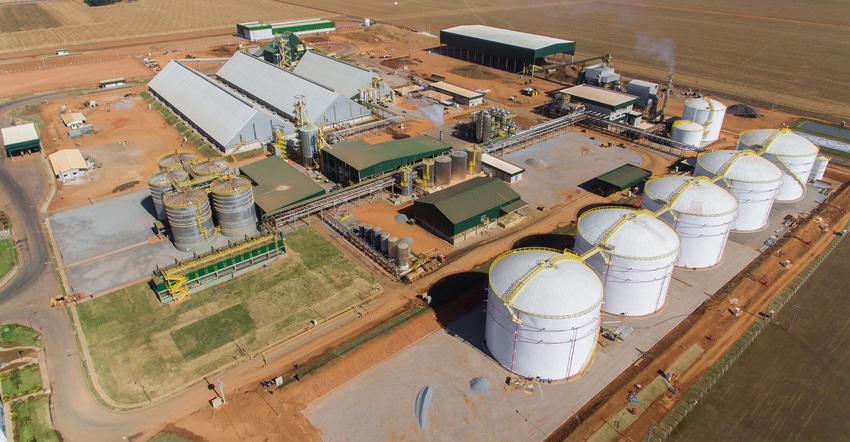August 21, 2017

A major new player in the Brazilian biofuels industry has strong Iowa roots. A grand opening was held Aug. 11 signaling the start of operations at FS Bioenergia, a world-class $115 million corn-only ethanol production facility. Located in Lucas do Rio Verde, in the state of Mato Grosso, FS Bioenergia is the first large-scale corn ethanol production plant in Brazil. The new plant is the result of an international collaboration between Brazilian agribusiness Fiagril and U.S.-based Summit Agricultural Group headquartered in Alden, Iowa.
In its initial phase of operations, FS Bioenergia will annually process 22 million bushels of corn and produce more than 60 million gallons of corn ethanol. It will also produce 6,200 tons of corn oil and 170,000 tons of valuable feed rations for Brazil’s growing livestock industry. By 2018, FS Bioenergia’s second phase of operations will increase corn processing and ethanol production twofold.
“FS Bioenergia is the most modern and efficient ethanol production operation in the world and will revolutionize the biofuels landscape in Brazil,” says Bruce Rastetter, founder and CEO of Summit Agricultural Group. “Summit Ag Group and Fiagril are proud to have delivered this historic project to Mato Grosso, and we look forward to the development of the region as a leader in ethanol, corn and livestock production.”
Landmark project will add value for Brazil
FS Bioenergia’s corn ethanol operation is considered a landmark project in Brazil that will deliver immediate value to the country. First, the plant will offset Brazil’s increasing demand for domestic ethanol, which can’t be met by the existing sugarcane ethanol production. Second, the facility will introduce to Mato Grosso valuable fiber and protein coproducts as dried distillers grain to serve as high-value feed for the expanding Brazilian livestock industry.
“This is a transformative moment for both agriculture and the renewable fuels industry in Brazil,” said Marino Franz, founder of Fiagril. “FS Bioenergia will not only meet Brazil’s growing demand for ethanol but it sets the stage for Mato Grosso to become a global leader in the production of corn ethanol.”
Brazil began sugarcane ethanol production in the mid-1970s and today produces approximately 25% of the world’s ethanol. Bank of America estimates annual ethanol sales in Brazil could reach 13.5 billion U.S. gallons in 2022, two-thirds greater than the 8.1 billion gallons estimated for sugarcane ethanol production in 2016. The Mato Grosso region’s substantial corn production — both proven and potential — makes corn-derived ethanol the most viable option to complement existing sugarcane ethanol production and fulfill an annual multibillion gallon shortfall.
Facility to generate electricity for grid
Summit Ag Group and Fiagril broke ground on the corn-only ethanol production facility in early 2016. FS Bioenergia will employ roughly 150 full-time workers. In addition to ethanol and coproducts for livestock feed, the ethanol facility will generate 60,000 megawatts of electricity to the local power grid.
FS Bioenergia uses process technologies from ICM Inc. of Colwich, Kan. Since 1995, ICM has provided engineering, construction and operational services for more than 100 ethanol plants in North America.
Rastetter attended the inauguration of the plant in Brazil Aug. 11. The president of Brazil and his ag minister were among the officials attending. “They were happy to see Brazil’s first corn ethanol plant making ethanol, and they vowed it would not be the last,” says Rastetter. “They voiced strong support for more corn-based ethanol production.” Current corn prices in Brazil are below cost of production, and Brazil’s president lamented that there weren’t 10 more of these plants online to help absorb Brazil’s huge corn crop.
New plant’s ethanol production stays in Brazil
Will the new plant produce ethanol for Brazil or for export? Rastetter says the new plant’s production will all be consumed in Brazil, rather than exported.
Why did Rastetter, who has experience starting ethanol plants in Iowa, go to South America to produce ethanol? One reason is Brazil’s ability to double-crop, he says. Farmers there can raise two crops per year on the same land. Also, Brazil is continuing to increase corn production. It is producing its largest corn crop in history this year at 100 million metric tons. Mato Grosso, one state, is producing 30 million metric tons, or about 1 billion bushels. In comparison, Iowa produced about 3 billion bushels of corn last year.
The ethanol blend rate in Brazil is 27.5%, compared to the 10% ethanol blend (E10) that’s widely available in the United States. Their higher blending rate is a key reason Brazil imported 500 million gallons of ethanol from the U.S. last year to help meet Brazilian ethanol demand. “They have blender pumps at every gas station,” says Rastetter. “That’s what the U.S. needs. In Brazil, if you want to pump 100% ethanol into your car, you can do it. You dial your blend on the pump, and it’s based on gasoline prices.”
Ethanol future good for U.S., Brazil
“Farmers in Brazil are excited to be producing ethanol and consuming their corn in their own country, rather than trying to export corn,” says Rastetter. Brazil’s market for ethanol is about 6.5 billion gallons per year compared to approximately 15 billion in the United States.
“I believe there’s a future for ethanol, a growing future,” he adds. “Our ability in the U.S. to produce corn is clearly evident. Also, we’re using our corn efficiently in ethanol production, and we’re still able to export corn around the world. That’s another reason we should have higher blends of ethanol widely available in the U.S., rather than the 10% blend now commonly used.”
Summit’s diverse operations include row-crop, beef cattle and pork farms in the U.S. and a growing presence in the South American biofuels market. For more information, go to summitag.com. Fiagril, fiagril.com.br/en-us, founded in 1989, has developed agriculture operations in Mato Grosso as a model for other regions of Brazil for over 25 years.
About the Author(s)
You May Also Like






